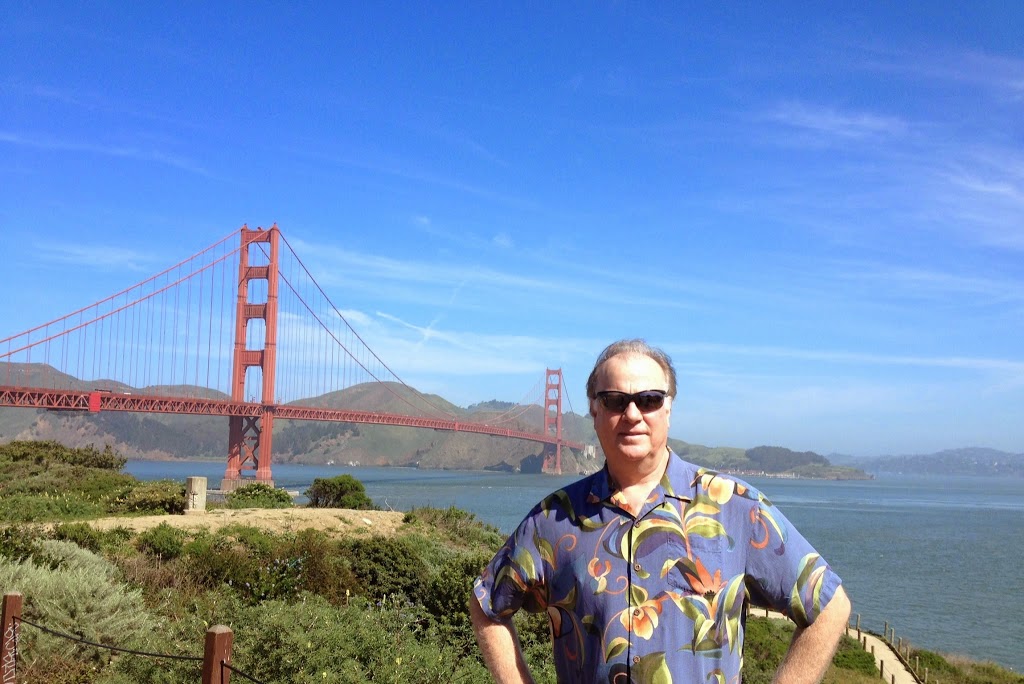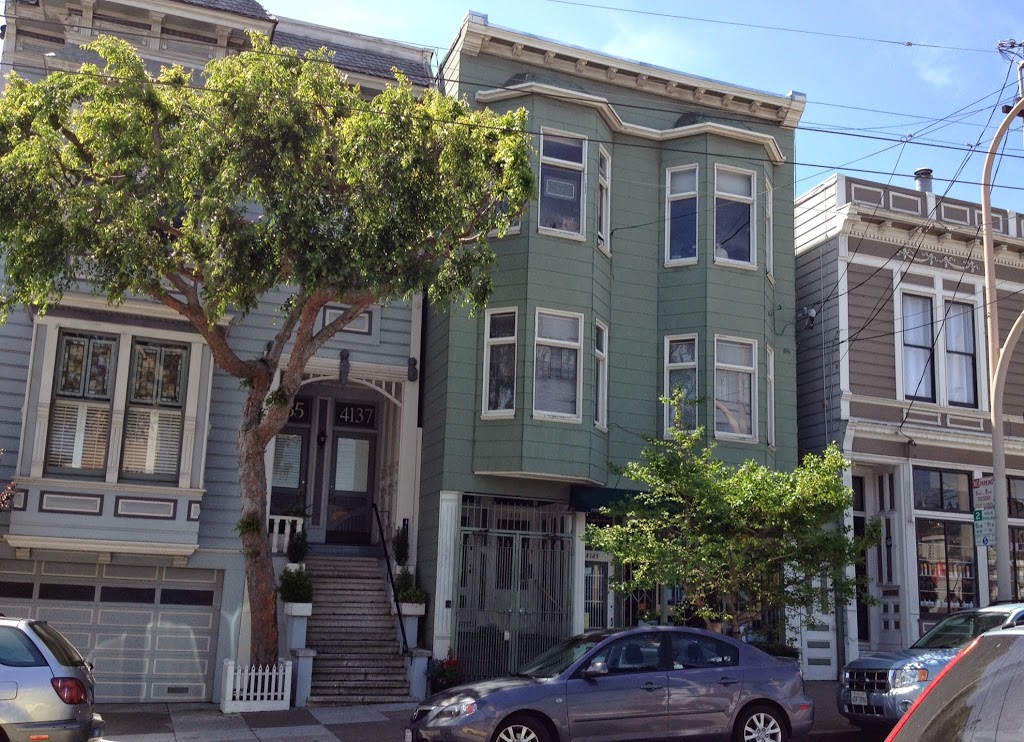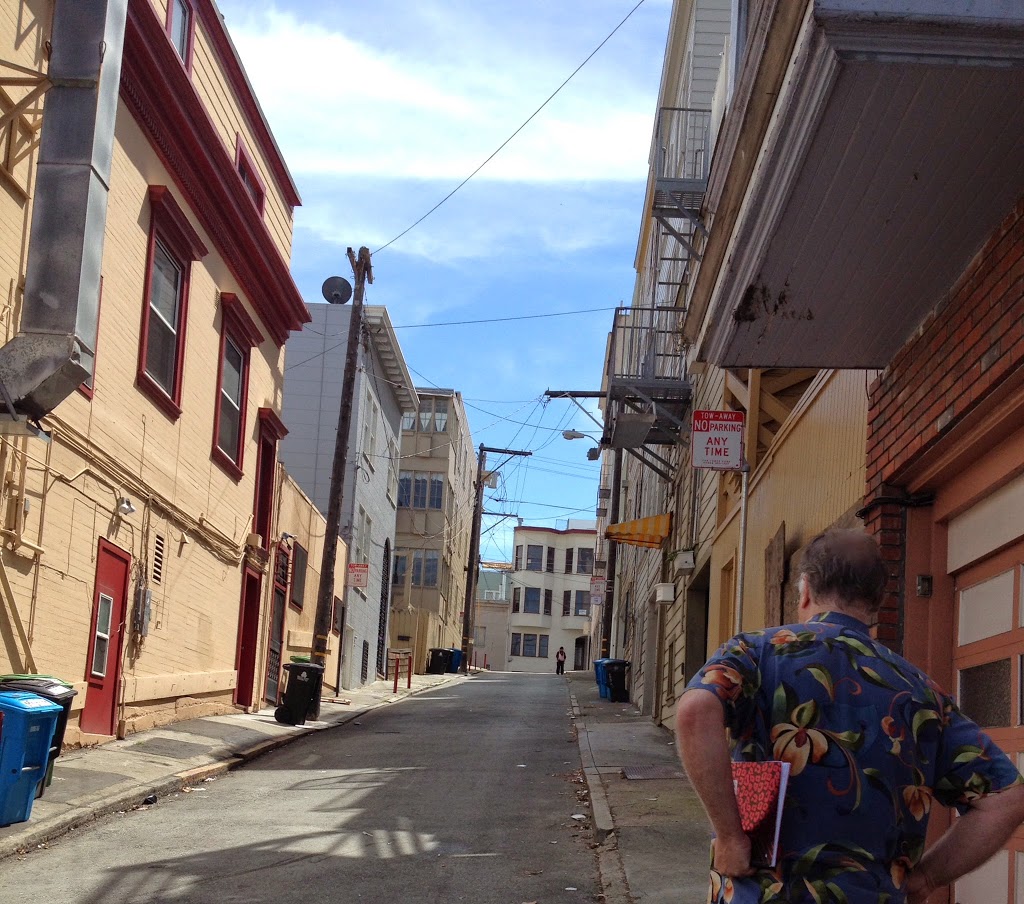It’s nice being married to your research assistant. It makes location work so much easier, especially when that location is a place like San Francisco.
A couple of weeks ago Mrs. B and I took a trip to the City by the Bay. I am working on a thriller that takes place largely in SF. This is not an easy thing for a Dodgers fan to do, but hey, this is my job. Unfortunately, during our two-day stay, the Dodgers managed to drop two games to the Giants, both by one run and after having the lead…not that I noticed, you understand.
Anyway, these are the steps I take to do my location research: Prepare. Go. Observe. Record. Integrate.
1. Prepare
Before the trip itself, I completed the San Francisco scenes to the best of my ability. I used Google Earth and Maps, and did general research on the internet to get as many details right as I could. It’s amazing how much we can do online these days. But I’m still of the opinion that there’s nothing like being on location, walking around, taking in the vibe, the sights, the sounds and yes, even the smells.
Then I got a city map and circled in red the key locales in my story. Thus, I knew the places I wanted to go before I got there.
2. Go
On our first full day in the city, it was a simple matter of setting out with my trusty assistant and following my map with the circles.
We were staying at The Hotel Drisco in Pacific Heights (a key location in the book). Our day started with us driving through The Presidio, and along the west edge of the city until we got to Golden Gate Park. Then we cut back across town.
We stopped where Van Ness meets 18th Street. This is another location in my novel.
3. Observe
We got out and just started walking around, looking at the buildings and the storefronts, and for little passageways I hoped were there. They were. Always nice to find out a location works like you’ve seen it in your imagination. I even found a building that could serve as the one I’d made up for my story. And here it is:
Next stop, Pier 40, over on the east side of the city. This is the spot where my Lead meets a stranger who is going to take him on a nighttime boat ride. I knew from my research that you could see AT&T Park from the pier. I just didn’t realize how close. Being on the spot brought more vivid details for my eventual use.
We next drove over to North Beach, which has three spots I’m using in my story. We parked right in front of one of them, a church, then strolled over to Columbus Avenue for a sidewalk café lunch (research assistants have to be fed). But even this was an opportunity. I like to watch people walk by, look at their faces, try to imagine what their lives are like. I jotted some notes in between bites of my prime rib panini.
After lunch we walked around the neighborhood (which the city fathers had the unmitigated gall to place UPHILL) and took several pics. Walking around is when the magic of serendipity happens. A crucial incident in my book takes place in an alley at night. I wasn’t entirely sure one existed. But we came across the perfect alley for the story, just because we were using shoe leather:
4. Record
Of course it goes without saying that you take pictures and notes of what you observe. It’s helpful if you have a checklist of items that will remind you what to look for. Here’s mine:
Date of Visit.
Weather.
Sights.
Sounds.
Smells.
People walking by (descriptions, expressions on faces).
Buildings, architecture.
Signs, commercial establishments.
Views.
Miscellaneous notes.
5. Integrate
As soon as you get back from your trip, begin immediately to integrate your research into your WIP. Go to those scenes you pre-wrote and weave in the details. The sooner you do this, the better. You want to write while the memories are fresh.
If you are still in the planning stages of the story, write a few “practice” scenes containing your data. Doing so will preserve the vitality of the observations. You can use them later as the needs arise in your project.
For more on location work, see Nancy’s post here.
So what about you? Do you like doing research on location? Do you have a memorable experience you’d like to share with us?




Every place I visit, I perform these steps and some. I don’t even have them in mind for a story. I feel like I have to preserve each moment. I bring my notepad, recorder, and camera.
I now have so many places to use as locations for stories and no story. lol
Oh well, it’s still fun to be somewhere other than your own backyard. We visited Salem, MA last Halloween and the Bahamas this past Valentine’s Day. I want to use both experiences in novels, I just have to get on the ball and weave the story!
Indeed, Diane, since all of life is material, every place you go is a potential setting. That’s how we roll, isn’t it?
Yep! Just in case, document it. I even took a picture of a drunk man passed out on a flea market vending table once. Definitely must find a story for that one!
I really love this post, Jim. Like you, I start with online research. The Google map “yellow man” will put you on any street corner for a 360 view, but there’s nothing like walking a locale. The vibe is palpable in great locations & I love your reminder on recording what you see, smell, etc. Makes me want to hit another location for research.
One additional thing I would suggest is to think about book launch promo after you finish the book. You can post pictures on Pinterest to create a compilation of settings, foods, venues, & character images for your book or series to give a tantalizing flavor of your work.
For key books, you may also want to post a “Story Behind the Story” & include excerpts of the writing you used to describe the scene. Readers can get a better sense of the location with the visuals, even after they’ve read your book & want to look you up on your website or blog.
Whenever I start a new series, I do something like this. These images come in handy for virtual book tour stops as a topic for launching your novel.
Great tips, Jordan. And now we can even put the pictures themselves in the book. I suggested this early on to Hachette, and they did this with the e-version of Try Dying. But self-publishing writers can do the same, just like the fiction 100 years ago where illustrations were common.
I love this idea. Hadn’t thought about it in indie pubbed books. The enhanced readers notion is like the extras on DVDs for films. Yes, why not?
This is sheer genius. Thanks!
At TKZ, we only allow sheer genius to be posted.
My current WIP opens on Wall St. My daughter conveniently attented the Culinary Institute in Hyde Park, a but upstream from NYC. During our last visit, I convince my wife to check out Wall St. with me. Good thing, too. I had no idea they’ve banned vehicle traffic on Wall St. And they’ve moved the bull to another street. I also didn’t realize that the historic Trinity Church was clearly visible from most of the street. It became an important symbol in the opening chapters of my novel. The rest of the novel takes place in a fictional Ohio town. Cowardly, yes, but I had specific requirements, and no small Ohio towns were willing to build what I needed. They’re always rude to Michiganders.
Nice, Ron. That’s “research by walking around.”
And there’s nothing wrong with fictional towns. It worked for Faulkner, Ross Macdonald, Ed McBain, and is now for Sue Grafton. Millions of readers don’t seem to mind!
I enjoyed this post. Like Diane Carlisle, I like to pay attention to these sorts of things wherever I go. It’s all good information. In San Francisco, won’t the topography have a strong influence on your characters? Like, what kind of shape do you have to be in to pursue someone on foot? What happens to your water bottle if you drop it on the sidewalk? It’s a fun place. Thank you.
Lance, maybe 30% of what we need to do as writers is simply “pay attention.”
Timely post for me, Jim. Thanks for the tips. Our youngest is graduating high school this year, so we’re taking a big family trip to Peru. We’re going to see Machu Picchu and the Amazon rainforest. I haven’t got any WIPs about those areas, but I figure I’ll take copious notes and pictures.
Yes, turn your trips into material!
I, too, made a trip to SF recently to research. I’d been there many times in the past but not in the last seven years and though SF is one of those lovely towns that doesn’t change, it actually does. So I knew I couldn’t count on my gilded memories. Plus, I had to find locations in non-tourist areas and a few shady locales that even locals avoid. Like you and others say, you can get a lot from Google and the follow the little yellow man as he walks the streets anywhere in the world (Except Mackinac Island in Michigan!) you can’t capture the smells, sighs and sounds that you need. Like those foghorns, the ducks hanging in the window of the Korean shop on Clement Street, and the smell of the eucalyptus trees in the Panhandle on a chilly morning.
To say nothing of the young woman I talked to while waiting for the 43 bus in the Haight who claimed she was the reincarnation of Janis…
So Janis is back, eh? In Vegas, she can catch up with Elvis.
Seriously, though, finding quirky characters is another benefit of walking around. Thanks for the reminder.
My writing partner and I drove into San Francisco several years ago for our first ever book reading. We drove down the day before the scheduled event. Traffic came to a dead halt, it took over an hour to cross the Bay Bridge and almost an hour to get across the first intersection. I called my wife at home in Oregon. She went on line and discovered we had unwittingly driven into S.F. on Gay Pride Day and were in the middle of the city’s annual worst traffic. I will admit, it was the most colorful traffic jam I’ve ever been in. My wife was able to reserve us the very last hotel room in the city, which took us three hours to get to. My partner has vowed NEVER to return. I will, but I’ll check the calendar first.
Now that’s what I call driving into material.
This is a wonderful post! I love your specific questions.
I also found that reading books on travel writing helps me get into the right mindset. There’s excellent tips on how to capture the essence of the place quickly, as well as how to integrate it into your writing.
Recently we moved to Puerto Rico from Georgia for my husband’s job. It’s been a really great experience and I’m also taking lots of notes for my writing.
I write urban fantasy, so I don’t always write about places that are real, but I do use real details to make the imaginary places come alive. Experiencing different locations and climates helps that.
I do use real details to make the imaginary places come alive. Experiencing different locations and climates helps that.
Excellent point, Elizabeth. We want our fantasy worlds to feel just as “real” in context. These details are a great way to do it.
My mother grew up in PR. Her father was there with the Roosevelt admin.
That must have been very interesting for your mother to experience the political shifts. I know it’s something that comes up a lot, since my husband works for the government.
It’s a beautiful country, with truly delicious food. We’re having a blast!
Thanks for the great tips.
My current WIP is set in Amish country, so visits to northern Indiana and northern Ohio were very valuable – sights and sounds and smells – definitely.
Did the Dodgers play the Giants in SF? Just wondering.
Hate to break it to you, Steve, but Amish fiction just doesn’t sell.
I visited London and while walking around the square where my (fictional) Ursula lived I was stopped by police as they are very sensitive of people taking photographs there. Once I showed them a copy of my book and explained I was there to do research, they gave me a guided tour of all he famous people who’d lived in the square!
Well, you do have a suspicious look about you, Clare. Glad you weren’t, what’s the word, nicked?
I did pretty much the same thing on a trip to Portland last year. I had looked at Pioneer Square on Google Earth, but being there in person was priceless. Of course, we made sure to stop at Powell’s, Voodoo Donuts, and Stumptown Coffee. All in the name of research.
Ah, I love Powell’s. I’ll have to try the other two next time I’m there. Thanks, Carrie.
To date, I’ve kept my locales close to home but I have one story that I’ll end up overseas if I really want to do it justice. It’s not just the unfamiliar scents and sounds or trying to properly place scenes.
To write the story I want to, I need to learn to think like the people that will populate my story. What I will need will be months (at the very least) of experience, not of the new taste but that new taste as a familiar one, odd sights as normal, etc.
Like learning a second language, once I can think in the culture, I’ll be able to write it clearly and cleanly, bridging a gap between two worlds. All the sensory details then get put in from a framework that will support it.
Long ago Dean Koontz wrote a thriller that takes place in Japan, and used nothing but printed travel guides. I guess is can be done…still….